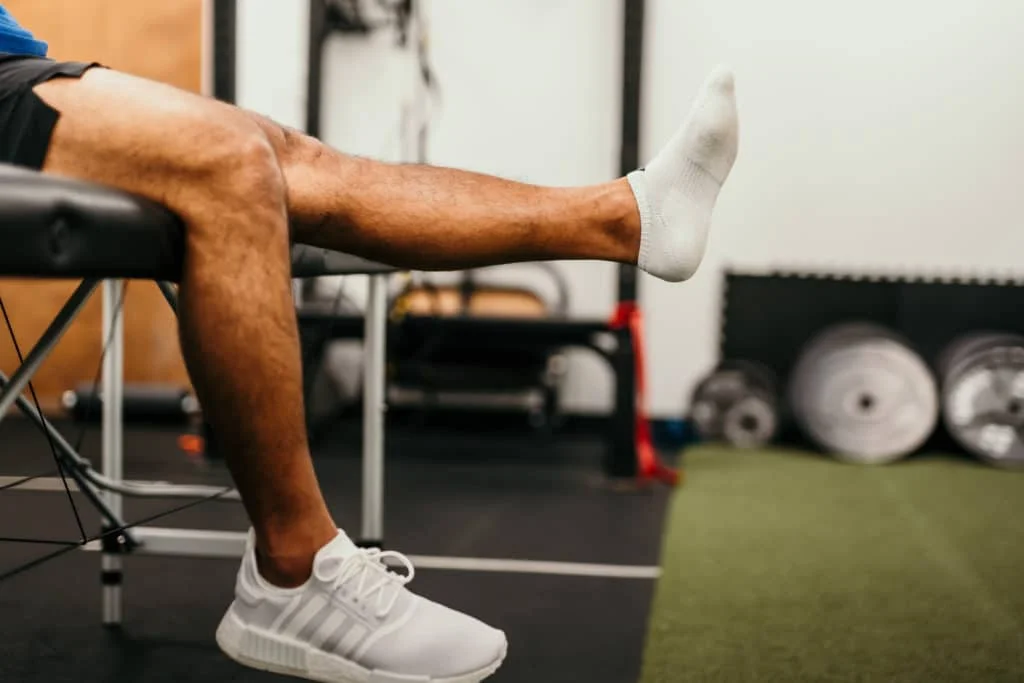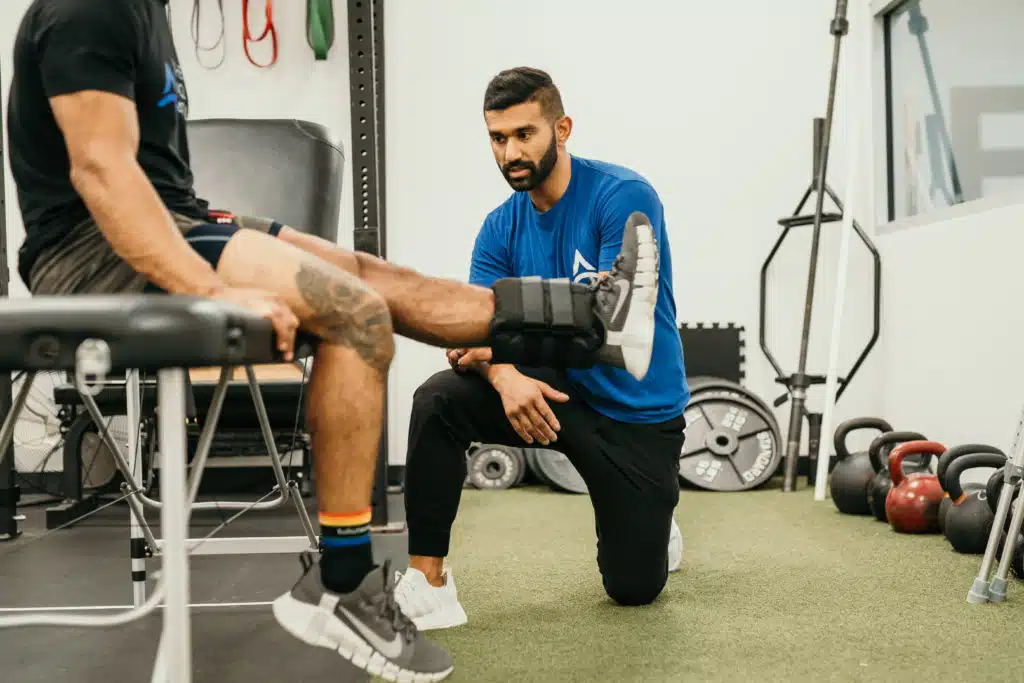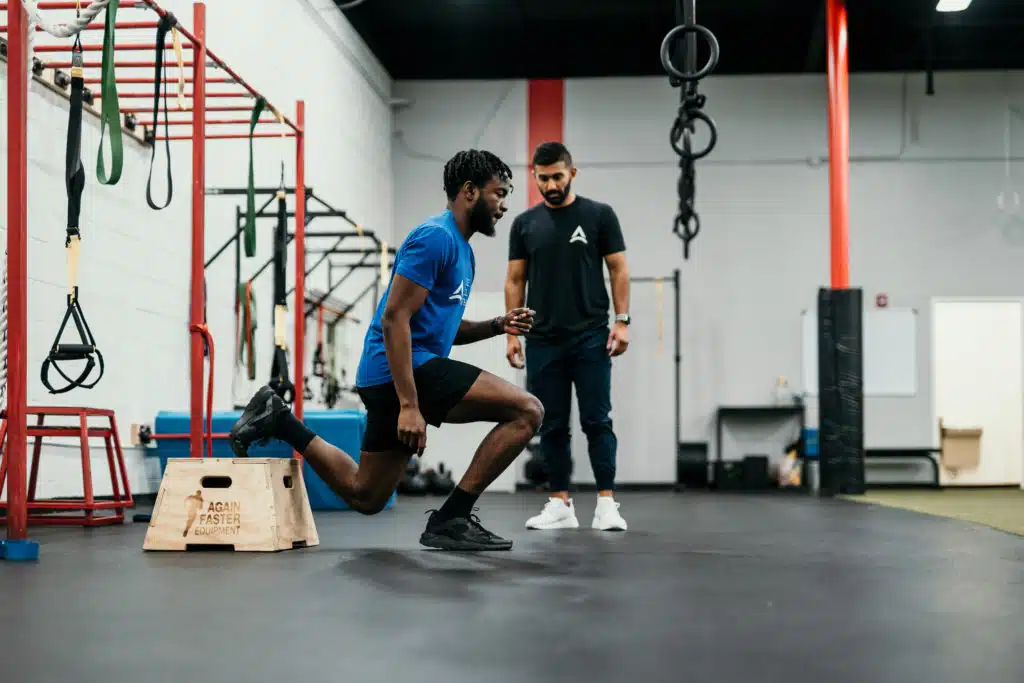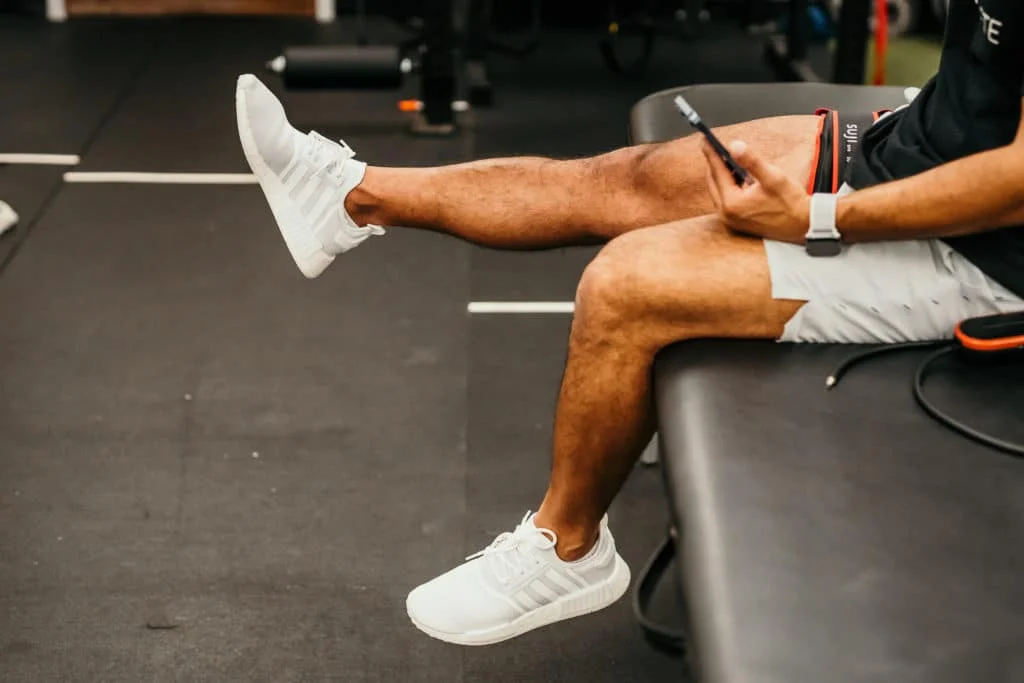Quadriceps strength and capacity is one of the most critical components of comprehensive ACL rehab, which is why we spend a lot of time and effort trying to implement strategies, programs, and exercises that reduce barriers to improving quadriceps gainz for our ACLers. One of the toughest barriers to overcome in ACL rehab isn’t physical, it’s an outdated narrative still being perpetuated by physicians, surgeons, rehab clinicians, and fitness professionals.
One of the most common things we hear from our post-operative ACL athletes is that they have been told that knee extensions are not safe. Historically, surgeons and physical therapists have condemned knee extensions and other open chain exercises (meaning your foot/leg is free to move through space even while resisted) for two reasons:
- Knee extensions place too much strain on the ACL graft, predisposing it to becoming loose or failing
- Closed chain (meaning your foot/leg is fixed, therefore you move your body through space) exercises are more “functional” for rehab and return to sport purposes
Well, I’m here to tell you that the current body of evidence indicates that knee extensions do not lead to graft laxity. Not only are they safe, but they can be beneficial to your rehab progress when appropriately utilized.

The ACL and Strain with Different Activities
Our first statement to debunk is that open-chain tasks place too much strain on the ACL graft. First, let’s look at the relative percent strain placed on the ACL with common tasks and exercises performed after surgery.
| Task | % ACL Strain |
| Walking | 13% |
| Isometric Quad Contraction (30Nm) @ 15˚ flexion | 4.4% |
| Seated 10lb knee Extension @ 10-15˚ flexion | 3.8% |
| Air Squat | 3.6% |
| Lachman’s Test @ 15-30˚ flexion | 3.5% |
| Seated Unresisted knee Extension @ 15˚flexion | 2.8% |
| Isometric Quad Contraction (30Nm) @ 60 & 90˚ flexion | 0% |
As you can tell from the table above, walking places 13% strain on the ACL, while seated isometric quadriceps contractions and seated knee extensions place less than 5% strain on the ACL. Even more notable is that isometric contractions up to 30Nm (roughly 22 ft-lbs of torque) between 60˚ and 90˚ of knee flexion place 0% strain on the ACL.
Does this mean that we shouldn’t be walking during the early stages of ACL rehab due to ACL graft strain?
No! First, strain isn’t inherently “good” or “bad.” It’s just important to contextualize the forces that the ACL experiences during certain tasks so that we can make an informed decision of how much and when to place stress on the ACL graft and knee joint musculature while respecting the graft healing process.
Strain and stress are necessary for tissue adaptation and for strength development, both of which are needed throughout the ACL recovery process.
So how can an exercise that objectively places less strain on the newly reconstructed graft than walking be considered dangerous? Based on the research above and the overall current body of evidence, I do not believe we can label knee extensions “unsafe.”
Now, this isn’t a free pass to try and load up the knee extension machine with as much resistance as humanly possible immediately postoperatively. External load selection is still important to consider in the context of each individual’s capabilities and timeline. Dosage matters!
Why Knee Extensions are Functional
Our next myth to debunk is that closed-chain exercises are more “functional” than open-chain exercises. Closed-chain exercises like squats and deadlifts have long been touted to be more functional because at first glance, they resemble closed-chain tasks and positions that commonly occur in sport. However, athletes with quadriceps strength deficits (aka everyone that has had ACL surgery) tend to adopt compensatory strategies during closed chain tasks to account for decreased quadriceps strength.
In the instance of ACL recovery, one of the ways we see this compensation manifest in the presence of quadriceps strength deficits is through the adoption of a “hip strategy.” Erik Meira talks about this in great detail in his blog “Why a Quad Index Matters,” but I’ll provide the TLDR here:
- Quads function as primary knee extensors (they straighten your knee).
- Quads serve as the primary way we have to counter external knee flexion moments (forces that encourage the knee to bend).
- When someone doesn’t have the capacity to overcome an external knee flexion moment, they will generally compensate in a way that will reduce the moment arm. Usually this occurs through increased hip flexion with relatively minimal knee flexion (the hip strategy where the knee is less bent and butt is pushed back)
- If you’re reading this, you can probably understand why this strategy is not ideal at high speeds, and that’s because this is one of the most common scenarios in which ACL injuries occur (non-contact mechanism of injury involving a declaratory and/or change of direction movement in which the knee is minimally flexed between 0˚-30˚ combined with rotation and/or knee valgus).
Stay with me. We know what quads do. We know what strategies people will inadvertently and involuntarily adopt to compensate for decreased quadriceps peak torque capacity. So why wouldn’t we spend a great deal of time and effort doing everything in our power to make sure that folks can bring quads to the party in order to handle such forces?
ENTER KNEE EXTENSIONS.

Of all the lower body exercises involving free weights and machines, few are as easily accessible, modifiable, and as quad-isolating as knee extensions. They are nearly foolproof because there is zero learning curve to understanding how to kick your leg straight against resistance. Anyone with a globo-gym membership probably has access to a knee extension machine. Heck, you don’t even need a machine to partake in knee extensions. Bands, dumbbells, kettlebells, physioballs, and heavy furniture are all conducive to different variations of knee extensions that can be utilized throughout ACL rehab. You can find a lot of these variations in our free Isometric Guide.
Yes, there are countless ways to constrain and modify various closed-chain exercises to emphasize quadriceps. Using heel lifts, blocks, or lifting shoes during squats, lunges, and split squats are all great examples of how to bias an exercise to be more quad-dominant. But with more degrees of freedom involved in multi-joint movements, we can’t always be sure we’re emphasizing quads to the degree that we intend, which means we might not be maximizing our time and effort to improve quadriceps strength and capacity.

What I’m not saying is that open-chain exercises are better than closed-chain exercises. Both serve a very important role in training and rehab. Squats, lunges, step ups, step downs, and split squats are all tried and true exercises that have stood the test of time for good reason. I think it’s important to understand the “why” and “how” we choose and implement specific exercises in the context of ACL rehab rather than simply label them “good” or “bad”.
References:
Noehren B, Snyder-Mackler L. Who’s Afraid of the Big Bad Wolf? Open-Chain Exercises After Anterior Cruciate Ligament Reconstruction. J Orthop Sports Phys Ther. 2020 Sep;50(9):473-475. doi: 10.2519/jospt.2020.0609. PMID: 32867579.
Beynnon BD, Fleming BC, Johnson RJ, Nichols CE, Renström PA, Pope MH. Anterior cruciate ligament strain behavior during rehabilitation exercises in vivo. Am J Sports Med. 1995 Jan-Feb;23(1):24-34. doi: 10.1177/036354659502300105. PMID: 7726347.
Isberg J, Faxén E, Brandsson S, Eriksson BI, Kärrholm J, Karlsson J. Early active extension after anterior cruciate ligament reconstruction does not result in increased laxity of the knee. Knee Surg Sports Traumatol Arthrosc. 2006 Nov;14(11):1108-15. doi: 10.1007/s00167-006-0138-2. Epub 2006 Sep 6. PMID: 16955299.
Mikkelsen C, Werner S, Eriksson E. Closed kinetic chain alone compared to combined open and closed kinetic chain exercises for quadriceps strengthening after anterior cruciate ligament reconstruction with respect to return to sports: a prospective matched follow-up study. Knee Surg Sports Traumatol Arthrosc. 2000;8(6):337-42. doi: 10.1007/s001670000143. PMID: 11147151.
Fukuda TY, Fingerhut D, Moreira VC, Camarini PM, Scodeller NF, Duarte A Jr, Martinelli M, Bryk FF. Open kinetic chain exercises in a restricted range of motion after anterior cruciate ligament reconstruction: a randomized controlled clinical trial. Am J Sports Med. 2013 Apr;41(4):788-94. doi: 10.1177/0363546513476482. Epub 2013 Feb 19. PMID: 23423316.
https://www.youtube.com/watch?v=mi0rem-Tc3Y&t=158s

